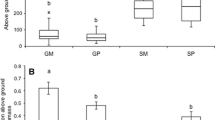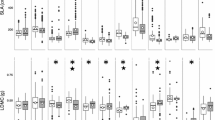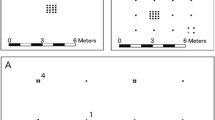Summary
Modern population ecology is becoming increasingly spatially-explicit. For insect hervibores, spatial variation in plant quality is a critical component of distribution and abundance. We argue that populationlevel measurements of phytochemical variation among individual plants has not kept pace with recent developments in population ecology. With examples from our own work, we demonstrate the importance of spatial variation in plant chemistry for insect herbivores, and suggest that phytochemistry should play a central role in the development of any spatially-based ecological theory.
Similar content being viewed by others
References
Bate-Smith EC (1977) Astringent tannins ofAcer species. Phytochemistry 16:1421–1426
Brodenfeldt R, Mohr H (1988) Time courses of phytochrome-induced enzyme levels in phenylpropanoid metabolism (phenylalanine ammonia lyase, naringenin-chalcone synthase) compared with time courses for phytochrome-mediated end-product accumulation (anthocyanin, quercetin). Planta 176:383–390
Brower LP, Glazier SC (1975) Localization of heart poisons in the monarch butterfly. Science 188:19–25
Brower LP, Calvert WH (1985) Foraging dynamics of bird predators on overwintering monarch butterflies in Mexico. Evolution 39:852–868
Brower LP, Nelson CJ, Seiber JN, Fink LS, Bond C (1988) Exaptation as an alternative to coevolution in the cardenolide-based chemical defense of monarch butterflies (Danaus plexippus L.) against avian predators, Pp 447–475in Spencer KC (ed.) Chemical Mediation of Coevolution. San Diego/CA: Academic Press
Bryant JP, Chapin FS, Klein DR (1983) Carbon/nutrient balance of boreal plants in relation to vertebrate herbivory. Oikos 40:357–368
Bryant JP, Tuomi J, Niemela P (1988) Environmental constraint of constitutive and long-term inducible defenses in woody plants. Pp 376–389in Spencer K (ed.) Chemical mediation of coevolution. San Diego/CA: Academic Press
Bryant JP, Reichardt PB, Clausen TP, Werner RA (1993) Effects of mineral nutrition on delayed inducible resistance in Alaska paper birch. Ecology 74:2072–2084
Calvert WH, Hedrick LE, Brower LP (1979) Mortality of the monarch butterfly (Danaus plexippus L.): avia predation at five overwintering sites in Mexico. Science 204:847–851
Cappuccino N, Price PW (eds) (1995) Population Dynamics: New Approaches and Synthesis. San Diego/CA: Academic Press
Carver TLW, Robbins MP, Zeyen RJ (1991) Effects of two PAL inhibitors on the susceptibility and localised autofluorescent host cell responses of oat leaves attacked byErysiphe graminis. Physiol Molec Plant Pathol 39:269–287
Cates RG, Zou J (1990) Douglas-fir (Pseudotsuga menziesii) population variation in terpene chemistry and its role in budworm (Choristoneura occidentalis Freeman) dynamics. Pp 169–182in Watt AD, Leather SR, Hunter MD, Kidd NAC (eds) Population Dynamics of Forest Insects. GB-Andover: Intercept
Chapin FS III (1980) Nutrient allocation and responses to defoliation in tundra plants. Arctic and Alpine Res 12:553–563
Cobb NS, Whitham TG (1993) Herbivore deme formation on individual trees: a test case. Oecologia 94:496–502
Cockrell BJ, Malcolm SB, Brower LP (1993) Time, temperature, and latitudinal constraints on the annual recolonization of eastern North America by the monarch butterfly. Pp 233–251in Malcolm SB, Zalucki MP (eds) Biology and Conservation of the Monarch Butterfly. Los Angeles/CA: Natural History Museum of Los Angeles County, Science Series 38
Creasy LL, Zucker M (1974) Phenylalanine ammonia lyase and phenolic metabolism. Pp 1–19in Runeckles VC, Conn EE (eds) Metabolism and Regulation of Secondary Plant Products. Rec Adv Phytochem 8. New York: Academic Press
Da Cunha A (1987) The estimation of L-phenylalanine ammonia lyase shows phenylpropanoid biosynthesis to be regulated by L-phenylalanine supply and availability. Phytochemistry 26:2723–2727
Denno RF, McClure MS (eds) (1983) Variable Plants and Herbivores in Natural and Managed Systems. New York: Academic Press
Doane CC (1970) Primary pathogens and their role in the development of an epizootic in the gypsy moth. J Invert Pathol 15:21–33
Dolinger PM, Ehrlich PR, Fitch WL, Breedlove DE (1973) Alkaloid and predation patterns in Colorado lupine populations. Oecologia 13:191–204
Edmunds GF, Alstad DN (1978) Coevolution in insect herbivores and conifers. Science 199:941–945
Ehrlich PR, Raven PH (1966) Butterflies and plants: a study in coevolution. Evolution 18:586–608
Feeny P (1976) Plant apparency and chemical defense. Rec Adv Phytochem 10:1–40
Feeny P, Rosenberry L (1982) Seasonal variation in the glucosinolate content of North AmericanBrassica nigra andDentaria species. Biochem Syst Ecol 10:23–32
Fink LS, Brower LP (1981) Birds can overcome the cardenolide defence of monarch butterflies in Mexico. Nature 291:67–70
Foster MA, Schultz JC, Hunter MD (1992) Modeling gyspy moth-virus-leaf chemistry interactions: implications of plant quality for pest and pathogen dynamics. J Anim Ecol 61:509–520
Fritz RS, Simms EL (1992) Ecology and evolution of plant resistance. Chicago/IL: University of Chicago Press
Funk C, Brodelius P (1990) Influence of growth regulators and an elicitor on phenylpropanoid metabolism in suspension cultures ofVanilla planifolia. Phytochemistry 29:845–848
Gershenzon J (1984) Changes in the level of plant secondary metabolite production under water and nutrient stress. Pp 273–320in Timmerman BN, Steelink C, Loewus FA (eds) Phytochemical Adaptations to Stress. Rec Adv Phytochem 18. New York: Plenum Press
Gershenzon J (1994) Metabolic costs of terpenoid accumulation in higher plants. J Chem Ecol 20:1281–1328
Gershenzon J, Croteau R (1991) Terpenoids. Pp 165–219in Rosenthal GA, Berenbaum MR (eds) Herbivores: Their Interactions with Secondary Plant Metabolites. Vol. I. 2nd ed. San Diego/CA: Academic Press
Gershenzon J, Croteau R (1993) Terpenoid biosynthesis: The basic pathway and formation of monoterpenes, sesquiterpenes, and diterpenes. Pp 333–388in Moore TS Jr (ed.) Lipid Metabolism in Plants. Boca Raton/FL: CRC Press
Gilpin ME, Hanski I (1991) Metapopulation dynamics: empirical and theoretical investigations, GB-London: Academic Press
Glendinning JI, Bower LP (1990) Feeding and breeding responses of five mice species to overwintering aggregations of the monarch butterfly. J Anim Ecol 59:1091–1112
Glendinning JI, Alonso Mejia A, Brower LP (1988) Behavioral and ecological interactions of foraging mice (Peromyscus melanotis) with overwintering monarch butterflies (Danaus plexippus) in México. Oecologia 75:222–227
Goldwasser L, Cook J, Silverman ED (1994) The effects of variability on metapopulation dynamics and rates of invasion. Ecology 75:40–47
Hanks LM, Denno RF (1994) Local adaptation in the armored scale insectPseudaulacaspis pentagona (Homoptera: Diaspididae). Ecology 75:2301–2310
Hanski I, Kuussaari M, Nieminen N (1994) Metapopulation structure and migration in the butterflyMelitaea cinxia. Ecology 75:747–762
Hanson KR, Havir EA (1981) Phenylalanine ammonia lyase. Pp 577–625in Conn EE (ed.) Secondary Plant Products. Vol. 7in Stumpf PK, Conn EE (eds in chief) The Biochemistry of Plants: a Comprehensive Treatise. New York: Academic Press
Hartley SE, Firn RD (1989) Phenolic biosynthesis, leaf damage and insect herbivory in birch (Betula pendula). J Chem Ecol 15:275–283
Hassell MP, Southwood TRE, Reader PM (1987) The dynamics of the viburnum whitefly (Aleurotrachelus jelinekii Fraunf): a case study on population regulation. J Anim Ecol 56:283–300
Herms DA, Mattson WJ (1992) The dilemma of plants: to grow or defend. Quart Rev Biol 67:283–335
Holmes EE, Lewis MA, Banks JE, Veit RR (1994) Partial differential equations in ecology: spatial interactions and population dynamics. Ecology 75:17–29
Hunter MD (1996) Incorporating variation in plant secondary chemistry into a spatially-explicit ecology of phytophagous insects. In pressin Watt AD, Stork NE, Hunter MD (eds) Forests and Insects. GB-London: Chapman & Hall (in press)
Hunter MD, Schultz JC (1993) Induced plant defenses breached? Phytochemical induction protects an herbivore from disease. Oecologia 94:195–203
Hunter MD, Schultz JC (1995) Fertilization mitigates chemical induction and herbivore responses within damaged oak trees. Ecology 76:1226–1232
Janzen DH (1979) New horizons in the biology of plant defenses. Pp 331–350in Rosenthal GA, Janzen DH (eds) Herbivores: Their Interactions With Secondary Plant Metabolites. New York: Academic Press
Jones DH (1984) Phenylalanine ammonia lyase: regulation of its induction and its role in plant development. Phytochemistry 23:1349–1359
Kareiva PM (1994) Space: the final frontier for ecological theory. Ecology 75:1
Keating ST, Yendol WG (1987) Influence of selected host plants on gypsy moth (Lepidoptera: Lymantriidae) larval mortality caused by a baculovirus. Environ Entomol 16:459–462
Keating ST, Yendol WG, Schultz JC (1988) Host plant dependent differences in the susceptibility of gypsy moth larvae (Lepidoptera: Lymantriidae) to a Baculovirus as possibly influenced by foliage chemistry. Environ Entomol 17:952–958
Keating ST, McCarthy WJ, Yendol WG (1989) Gypsy moth (Lymantria dispar) larval susceptibility to a baculovirus affected by selected nutrients, hydrogen ions (pH), and plant allelochemicals in artificial diets. J Invert Pathol 54:165–174
Keating ST, Hunter MD, Schultz JC (1990) Leaf phenolic inhibition of the gypsy moth nuclear polyhedrosis virus: the role of polyhedral inclusion body aggregation. J Chem Ecol 16:1445–1457
Knypl JS, Janas KM, Wolska M (1986) Rhythmicity of L-phenylalanine ammonia-lyase activity inSpirodela oligorrhiza. Effects of darkening, abscisic acid and 1-ammino-2-phenylehthylphosphonic acid. Physiol Plant 66:543–549
Lande R (1987) Extinction thresholds in demographic models of territorial populations. Amer Natur 130:624–635
Langenheim JH (1994) Higher-plant terpenoids: a phytocentric overview of their ecological roles. J Chem Ecol 20:1223–1280
Levins R (1969) Some demographic and genetic consequences of environmental heterogeneity for biological control. Bull Ent Soc Am 15:237–240
Liang X, Dron M, Cramer C, Dixon RA, Lamb CJ (1989) Differential regulation of phenylalanine ammonia-lyase genes during plant development and by environmental cues. J Biol Chem 264:14486–14492
Lincoln DE, Langenheim JH (1979) Variation ofSatureja douglassi monoterpenoids in relation to light intensity and herbivory. Biochem Syst Ecol 7:289–298
Lincoln DE, Mooney HA (1984) Herbivory onDiplacus aurantiacus shrubs in sun and shade. Oecologia 64:173–176
Louda SM, Rodman JE (1983a) Ecological patterns in the glucosinolate content of a native mustard,Cardamine cordifolia, in the Rocky Mountains. J Chem Ecol 9:397–421
Louda SM, Rodman JE (1983b) Concentration of glucosinolates in relation to habitat and insect herbivory for the native cruciferCardamine cordifolia. Biochem Syst Ecol 11:199–207
Louda SM, Farris MA, Blua MJ (1987) Variation in methylglucosinolate and insect damage toCleome serrulata (Capparaceae) along a natural soil moisture gradient. J Chem Ecol 13:569–581
Lynch SP, Martin RA (1987) Cardenolide content and thin-layer chromatography profiles of monarch butterflies,Danaus plexippus L., and their larval host-plant milkweed,Asclepias viridis Walt., in northwestern Lousiana. J Chem Ecol 13:47–70
Malcolm SB (1991) Cardenolide-mediated interactions between plants and herbivores. Pp 251–296in Rosenthal GA, Berenbaum MR (eds) Herbivores: There Interaction With Secondary Plant Metabolites. 2nd ed. Vol. I: The Chemical Participants. San Diego/CA: Academic Press
Malcolm SB, Brower LP (1989) Evolutionary and ecological implications of cardenolide sequestration in the monarch butterfly. Experientia 45:284–295
Malcolm SB, Zalucki MP (eds) (1993) Biology and Conservation of the Monarch Butterfly. Los Angeles/CA: Natural History Museum of Los Angeles County, Science Series 38
Malcolm SB, Zalucki MP (1996) Milkweed latex and cardenolide induction may resolve the lethal plant defence paradox. Entomol exp appl: in press
Malcolm SB, Cockrell BJ, Bower LP (1987) Monarch butterfly voltinism: effects of temperature constraints at different latitudes. Oikos 49:77–82
Malcolm SB, Cockrell BJ, Bower LP (1989) The cardenolide fingerprint of monarch butterflies reared on the common milkweed,Asclepias syriaca. J Chem Ecol 15:819–853
Malcolm SB, Cockrell BJ, Brower LP (1993) Spring recolonization of eastern North America by the monarch butterfly: successive brood or single sweep migration? Pp 253–267in Malcolm SB, Zalucki MP (eds) Biology and Conservation of the Monarch Butterfly. Los Angeles/CA: Natural History Museum of Los Angeles County, Science Series 38
Margna U (1977) Control at the level of substrate supply: an alternative in the regulation of phenylpropanoid accumulation in plant cells. Phytochemistry 16:419–426
Martin RA, Lynch SP (1988) Cardenolide content and thin-layer chromatography profiles of monarch butterflies,Danaus plexippus L., and their larval host-plant milkweed,Asclepias asperula subsp.capricornu (Woods.) Woods., in north central Texas. J Chem Ecol 14:295–318
Martin RA, Lynch SP, Brower LP, Malcolm SB, Van Hook T (1992) Cardenolide content, thin-layer chromatography profiles and emetic potency of monarch butterflies,Danaus plexippus, and their larval host-plant milkweed,Asclepias humistrata, in central Florida. Chemoecology 3:1–13
Mathur AK, Ahuja PS, Padney B, Kukreja AK, Mandal S (1988) Screening and evaluation of somaclonal variations for quantitative and qualitative traits in an aromatic grass,Cymbopogon winterianus Jowwit. Plant Breeding 101:321–334
McCallum JA, Walker JRL (1990) Phenolic biosynthesis during grain development in wheat: changes in phenylalanine ammonia lyase activity and soluble phenolic content. J Cereal Sci 11:35–49
Molofsky J (1994) Population dynamics and pattern formation in theoretical populations. Ecology 75:30–39
Muzika R-M (1993) Terpenes and phenolics in response to nitrogen fertilization: a test of the carbon/nutrient balance hypothesis. Chemoecology 4:3–7
Muzika R-M, Pregitzer KS, Hanover JW (1989) Changes in terpene production following nitrogen fertilization of grand fir (Abies grandis (Dougl.) Lindl.) seedings. Oecologia 80:485–489
Muzika R-M, Pregitzer KS (1992) Effect of nitrogen fertilization on leaf phenolic production of grand fir seedlings. Trees 6: 241–244
Nelson CJ, Seiber JN, Brower LP (1981) Seasonal and intraplant variation of cardenolide content in the California milkweed,Asclepias eriocarpa, and implications for plant defense. J Chem Ecol 7:981–1010
Neuvonen S, Haukioja E (1991) The effects of inducible resistance in host foliage on birch-feeding herbivores. Pp 277–291in Tallamy DW, Raupp MJ (eds) Phytochemical Induction by Herbivores. New York: John Wiley & Sons
Nichols-Orians CM, Fritz RS, Clausen TP (1993) The genetic basis for variation in the concentration of phenolic glycosides inSalix sericea: clonal variation and sex-based differences. Biochem Syst Ecol 21:535–542
Nishio S (1980) The fates and adaptive significance of cardenolides sequestered by larvae ofDanaus plexippus (L.) andCycnia inopinatus (Hy. Edwards). Doctoral dissertation. Athens/GA: University of Georgia
Nothnagle PJ, Schultz JC (1987) What is a forest pest? Pp 59–80in Barbosa P, Schultz JC (eds) Insect Outbreaks. New York: Academic Press
Pilson D (1992) Aphid distribution and the evolution of goldenrod resistance. Evolution 46:1358–1372
Pulliam HR (1988) Sources, sinks, and population regulation. Am Nat 132:652–661
Rhoades DF, Cates RG (1976) Toward a general theory of plant antiherbivore chemistry. Rec Adv Phytochem 10:168–213
Rodman JE, Chew FS (1980) Phytochemical correlates of herbivory in a community of native and naturalized Cruciferae. Biochem Syst Ecol 8:43–50
Rosenthal GA, Janzen DH (1979) Herbivores: Their interaction with secondary plant metabolites. New York: Academic Press
Rosenthal GA, Berenbaum MR (eds) (1991). Hervibores: Their Interactions with Secondary Plant Metabolites. Vol. I. 2nd ed. San Diego/CA: Academic Press
Rossiter MC, Schultz JC, Baldwin IT (1988) Relationships among defoliation, red oak phenolics, and gypsy moth growth and reproduction. Ecology 69:267–277
Schultz JC (1983) Impact of variable plant defensive chemistry on susceptibility of insects to natural enemies. Pp 37–54in Hedin P (ed) Plant Resistance in Insects. Washington/DC: American Chemical Society
Schultz JC, Baldwin IT (1982) Oak leaf quality declines in response to defoliation by gypsy moth larvae. Science 217:149–151
Schultz JC, Foster MA, Montgomery ME (1990) Hostplant mediated impacts of a baculovirus on gypsy moth populations. Pp 303–313in Watt AD, Leather SR, Hunter MD, Kidd NAC (eds) Population dynamics of forest insects. Andover: Intercept
Simms EL, Rausher MD (1993) Patterns of selection on phytophage resistance inIpomea purporea. Evolution 47:970–976
Sjögren Gulve P (1994) Distribution and extinction patterns within a northern metapopulation of the pool frog,Rana lessonae. Ecology 75:1357–1367
Smith DAS (1978) Cardiac glycosides inDanaus chrysippus (L.) provide some protection against an insect parasitoid. Experimentia 34:844
Stewart-Oaten A, Murdoch WW (1990) Temporal consequences of spatial density dependence. J Anim Ecol 59: 1027–1045
Strauss SY, Karban R (1994) The significance of outcrossing in an intimate plant-herbivore relationship. 1. Does outcrossing provide an escape from herbivores adapted to the parent plant? Evolution 48:454–464
Tilman D (1994) Competition and biodiversity in spatially-structured habitats. Ecology 75:2–16
Wallner WE, McManus ML (1981) Population dynamics; historical review. USDA Tech Bull 1584:202–203
Waterman PG, Mole S (1989) Extrinsic factors influencing production of secondary metabolites it plants. Pp 107–134in Bernays EA (ed.) Insect-Plant Interactions. Vol. I. Boca Raton/FL: CRC Press
Waterman PG, Mole S (1994) Analysis of Phenolic Plant Metabolites. GB-Oxford: Blackwells
Watkinson AR, Sutherland WJ (1995) Sources, sinks and pseudosinks. J Anim Ecol 64:126–130
Weis AE, Campbell DR (1992) Plant genotype: a variable factor in insect-plant interactions. Pp 75–111in Hunter MD, Ohgushi T, Price PW (eds) Effects of Resource Distribution on Animal-Plant Interactions. San Diego/CA: Academic Press
Yamada T, Hashimoto H, Shiraishi T, Oku H (1989) Suppression of pisatin, phenylalanine ammonia lyase mRNA, and chalcone synthase mRNA accumulation by a putative pathogenicity factor from the fungusMycosphaerella pinodes. Molec Plant-Microbe Intns 2:256–261
Zangerl AR, Berenbaum MR (1990) Furanocourmarin induction in wild parsnip: genetics and populational variation. Ecology 71:1933–1940
Zangerl AR, Berenbaum MR (1993) Plant chemistry, insect adaptations to plant chemistry, and host plant utilization patterns. Ecology 74:47–54
Author information
Authors and Affiliations
Rights and permissions
About this article
Cite this article
Hunter, M.D., Malcolm, S.B. & Hartley, S.E. Population-level variation in plant secondary chemistry, and the population biology of herbivores. Chemoecology 7, 45–56 (1996). https://doi.org/10.1007/BF01240637
Issue Date:
DOI: https://doi.org/10.1007/BF01240637




